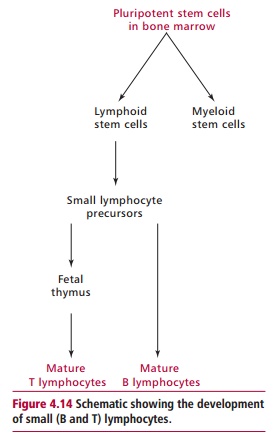Chapter: Biology of Disease: The Immune System
Small Lymphocytes
SMALL LYMPHOCYTES
Small lymphocytes are the cells responsible for specific
immunity (Figure4.2). They make up
approximately 20% of the blood leukocytes. There are twopopulations of small
lymphocytes that mature at different sites in the body and have distinct
functions (Figure 4.14).


The precursors of small lymphocytes originate in the bone marrow
by division of lymphoid stem cells.
Some small lymphocytes remain in the bone marrow where they mature into B lymphocytes. When maturation is
complete, B lymphocytes have antibodies on their surface that are receptors for
an individual epitope. Thus a single B lymphocyte is specific for an epitope
and is capable of clonal division and of making antibody to it when stimulated
appropriately by the immunogen. Thus they are responsible for humoral immunity.
The second population of small lymphocytes, known as T lymphocytes, leave the bone marrow when immature and complete
theirmaturation in the fetal thymus, a bilobed organ situated just above the
heart. During their development in the thymus, T lymphocytes first acquire
specificity for an epitope, by producing a cell surface receptor. They then
mature into one of two T cell subsets. Cells of the first subset are known as cytotoxicprecursors or TC cells. When
appropriately stimulated, TCcells develop into cytotoxic T lymphocytes (CTL) that are capable of killing
virus-infected cells.Cells of the second subset of T cells are the helper T lymphocytes or THcells. When stimulated by
an immunogen, TH cells develop into cytokine-secreting TH
cells that produce an array of cytokines that control the activities of both
specific and nonspecific cells of the immune system. Thus TH cells
have a central role in the regulation of all immune responses.
When mature, both B and T lymphocytes are released into the
circulation. However, small lymphocytes are not confined to the blood and many
move into the lymphoid tissues: the spleen, lymph nodes, tonsils and the
mucosa-associated lymphoid tissues found in the respiratory, gastrointestinal
and urogenital tracts. Small lymphocytes constantly move between the blood and
the lymphoid systems, a phenomenon known as recirculation. The route of this
recirculatory process is shown in Figure
4.15. Lymph is the fluid that drains from the tissues into small lymphatic
vessels. These merge with larger lymphatic vessels, the largest of which, the
thoracic duct, delivers the lymph to the blood at its junction with the left
subclavian vein. En route to the
thoracic duct, lymph is filtered through many lymph nodes.Small lymphocytes circulating
in the blood are able to move between the

endothelial cells lining the blood vessels that supply the lymph
nodes. These blood vessels have a specialized endothelium which aids this
process. By crossing the blood vessel wall, the small lymphocytes enter the
lymph node and from this they enter the lymphatics and, eventually, return to
the blood.
Related Topics